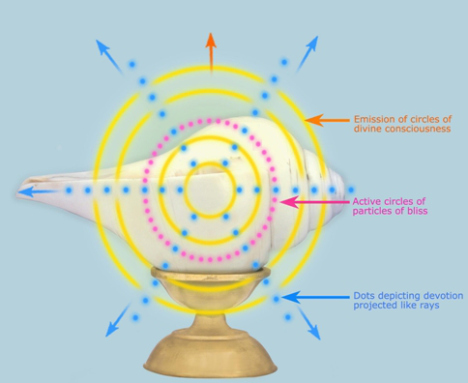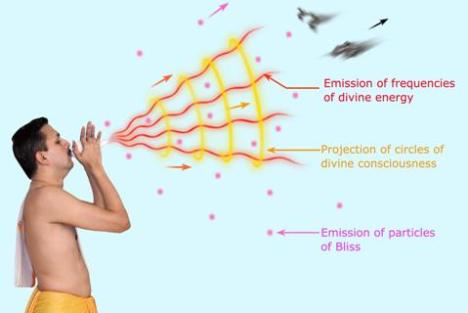VASTU SHASTRA
Shankha in Vastu

'Shankh' is of greater importance in Hinduism and Buddhism. In Hinduism the 'Shankh' is dedicated to Lord 'Vishnu'. 'Shankha' is highly praised in Hindu scriptuers as a giver of fame and prosperity. 'Shankh' is of two types one is for blow sound and other for the worship purpose. The daily blowing of the 'shankh' does save the person from the heart diseases.
Types of Shankha
Dakshinavarti Shankha
Vamavarti Shankha
Gaumukhi Shankha
Ganesha Shankha
Kauri Shankha
Moti Shankha
Heera Shankha
Shankh in Indian Mythology
- Shankh represents a number - one hundred zillion (or 100,000,000,000,000,000).
- Shankh in Indian mythology is also the name given to one of the nine treasures held by the god of wealth, Kuber.
- There is an attendant of Kuber also called Shankhnidhi, and he is shown as a corpulent dwarf seated in an easy posture holding a conch shell in one of his two hands. His companion is Padmanidhi, who resembles Shankhnidhi in all particulars except that he holds a lotus in his hand instead of a conch shell.
- It is most characteristically associated with Vishnu, and is one of His four "Aayudh" weapon', but employed in the sense of whatever is held in the hand usually found in his hands; the Discus (Chakra), the Mace (Gadaa) and the Lotus (Padm) being the other three than Shankh. The conch held by Vishnu is named Paanch-janya Shankh, even as the name of the Discus in His hand is Sudarshan and the name of His mace is Kaumodakee.
Importance of conch (shankh) as per scriptures
First of all let us se the importance of shankh. According to our ancient scriptuires that is Puranas, the shankh was originated during the Churning of ocean by the Deities and Lord Vishnu held it in the form of weapon. As per a holy verse which is regularly chanted during the puja ritual it is mentioned that by the command of Lord Vishnu the deities Moon, Sun and Varun are stationed at the base of the shankh, the deity Prajapati on its surface and all the places of pilgrimage like Ganga and Saraswati in its front portion. Yet another speciality of shankh is that the vibrations emanating on blowing it destroys the disease causing germs in the atmosphere. That is the reason it has a important place in Ayurved and medicine.
Let us see a subtle drawing which explains us the importance of shankh.

In this subtle drawing we can see that the yellow coloured circles of chaitanya are being emitted from shankh in the atmosphere. The subtle blue coloured dots depicting devotion are projected like rays in straight line. The pink circles are formed of particles of bliss (anand) and they are constantly active.
The direction of the space within the shankh divides it into two types. When the space is towards your right when you hold the shankh with its tip facing in frontal direction and with the space facing upwards then it is right sided shankh and if the space faces to left then it is a left sided shankh. Generally a left sided shankh is preferred for the puja ritual. Now days so many Shanks of different shapes are available in the market. There are some figured works also on their surface. Thus one gets confused as to how a genuine shankh be identified? The simple test is that without blowing the shankh if you hear pleasant sound when you bring it near to your ear then it is a genuine one.
Blowing of Shankh in puja ritual
The shankh is used in two ways in a puja ritual. One for blowing before the start of ritual and other for actual puja ritual. The shankh which is used for blowing should not be kept for puja.
Blowing of shankh has special significance in puja ritual. It has been mentioned in 'Varaha Puran' that one should not open the door of temple without first blowing the shankh. The left sided shankh is blown before the start of puja or performance of arti. There are three types of frequencies in the atmosphere namely sattva dominant, raja dominant and tama dominant. Among them the raja dominant and tama dominant frequencies generate distressing vibrations. The sattva dominant frequencies get attracted to the place of puja ritual but these frequencies are opposed by the raja and tama dominant frequencies so that they do not reach the place of puja and thus the flow of sattva frequencies is hindered.
When the shankh is blown before the start of puja energy is emitted from the shankh. This energy reduces the strength of distressing frequencies. Besides a protective armour of chaitanya (divine consciousness) is formed around the articles of puja.
There is another benefit too. That is when the shankh is blown the activated energy of Lord Vishnu in the universe gets attracted towards the place of worship which is not only beneficial to the person who is blowing the shankh but also to all those who hear it.
Just as the shankh is blown before the start of puja, it is also blown before an arti. The objective behind this being to sustain the deity's chaitanya attracted to the place of puja ritual and the pure atmosphere generated because of the sattvik frequencies, for a long period.
Effect of energy emitted from blowing of Shankh
Let us see how the energy is emitted from the blowing of shankh and what exactly happens with the help of a subtle drawing. Here we have to take into consideration the fact that while the vibrations of a subtle drawing are three dimensional we see them in the subtle drawing in a two dimensional form. For example the sphere will appear as a circle. Now let us look at the subtle drawing:

As soon as the shankh is blown the frequencies of divine energy (shakti) are emitted into atmosphere due to sound generated. These energy frequencies are seen in red colour. Along with these energy frequencies yellow circles of chaitanya are also projected in the atmosphere. You can also see the pink particles of Bliss being emitted in the atmosphere. This increases the proportion of shakti (energy), chaitanya and anand in the environment and that is why the negative energies get distressed and run away.
Thus it has become clear to us the importance of blowing shankh during puja ritual. The blowing of shankh makes the atmosphere holy and pure and conducive for the spiritual practice (sadhana) of the individual. Thus it becomes easier for an individual to receive maximum sattvik frequencies emanating from the deities.
Correct method of blowing Shankh
We have seen that because of blowing of shankh the frequencies consisting raja-tama particles are destroyed and at the same time the saviour and destroyer principle of a deity is awakened. Now let us see the correct method of blowing the shankh.
First slightly raise your neck and bend it little backwards and keep the mind focused. Take a deep breath and start to blow with increasing intensity. One should keep in mind that blowing of shankh should be completed in one single breath. When the shankh is blown in this way Sushumna channel of the individual gets activated and it helps in keeping a correct balance of raja and sattva particles related to Tej and Vayu elements. This awakens the saviour and destroyer principle of adeity according to the need.
Shankhini
There is another type of shankh which is neither supposed to be blown nor kept in the puja ritual. It is called female shankh or shankhini. Its surface is rough and thorny. It does not emit pleasant sound. Let us now see why a female shankh or shankhini is not used for blowing as per the science of spirituality.
There are several crisscross circles on the inner surface of shankhani. When you blow through it these circles create obstruction in the interrupted flow of sound vibrations. The sound vibrations when generated rub against these circles thereby producing distressing frequencies. These new distressing frequencies further activate the distressing frequncies already present in the atmosphere. Both the vibrations from the shankhani and those from the negative energies present in the atmosphere get attracte towards the place of puja and make the surrounding atmosphere impure. That is the reason shankhani is not used in the usual puja ritual. However the worshippers following the Aghori Vidya (worship to accumulate black energy) use the shankhani for attracting negative energies at the start of their worship.
Ritualistic worship of Shankh
During puja ritual the shankh is kept in a specific way. The pointed portion is directed toward the deity.
The frequencies of chaitanya and energy emanating from the images of deities get attracted to the pointed portion of shankh. You can also see the blue coloured Lord Krushna principle getting attracted towards shankh which is producing a armour of of Krushnatattva around shankh. The yellow coloured chaitanya is also attracted and spreads inside the shankh. The red coloured frequencies of energy are revolving in the space of shankh in a circular fashion. The frequencies of energy and chaitanya are emitted from the other end of shankh which purifies the atmosphere and thus benefits the worshipper.
When the shankh is kept with its pointed portion towards the deity then the house gets the energy emitted from the other end in required amount. Now let us know about ritualistic worship of shankh.
A shankh is filled with water prior to actual puja of a deity and following the puja of kalash. Then it is ritualistically worsipped by offerings of sandalwood paste, flowers and Tulsi leaves. After the shankh puja the worshipper sprinkles the water filled in shankh on himself and the articles of puja. The water filled in shankh is considered as pure as water of Ganga river. It is also used for giving holy bath (abhishek) to the deities.
Important points to be noted while using a Shankh
Now let us now see some useful points about shankh
- Never use shankh meant for blowing in a puja ritual. They should be separate.
- Never offer water to the deity by shankh used for blowing.
- Do not keep two shankhs for worship in a temple room.
- Never touch the Shiva pindi with shankh during a puja ritual.
- Never use shankh for giving holy bath to deities Shiva and Sun.
Er. Rameshwar Prasad invites you to the Wonderful World of Vastu Shastra
Engineer Rameshwar Prasad(B.Tech., M.Tech., P.G.D.C.A., P.G.D.M.) Vaastu International
|

